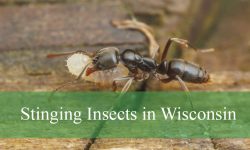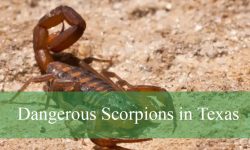Ohio hosts a variety of ant species, and several are capable of biting when threatened. Knowing how to identify these ants can help residents prevent bites and safely manage encounters.
From tiny Thief Ants to larger Carpenter Ants and Allegheny Mound Ants, each species has unique physical traits, behaviors, and habitats. Recognizing these differences is essential for homeowners, gardeners, and outdoor enthusiasts.
This guide highlights 9 common biting ants in Ohio, offering detailed descriptions, identification tips, habitats, and safety advice to help you stay informed and protected.
Different Types of Biting Ants Found in Ohio
Thief Ant (Solenopsis molesta)
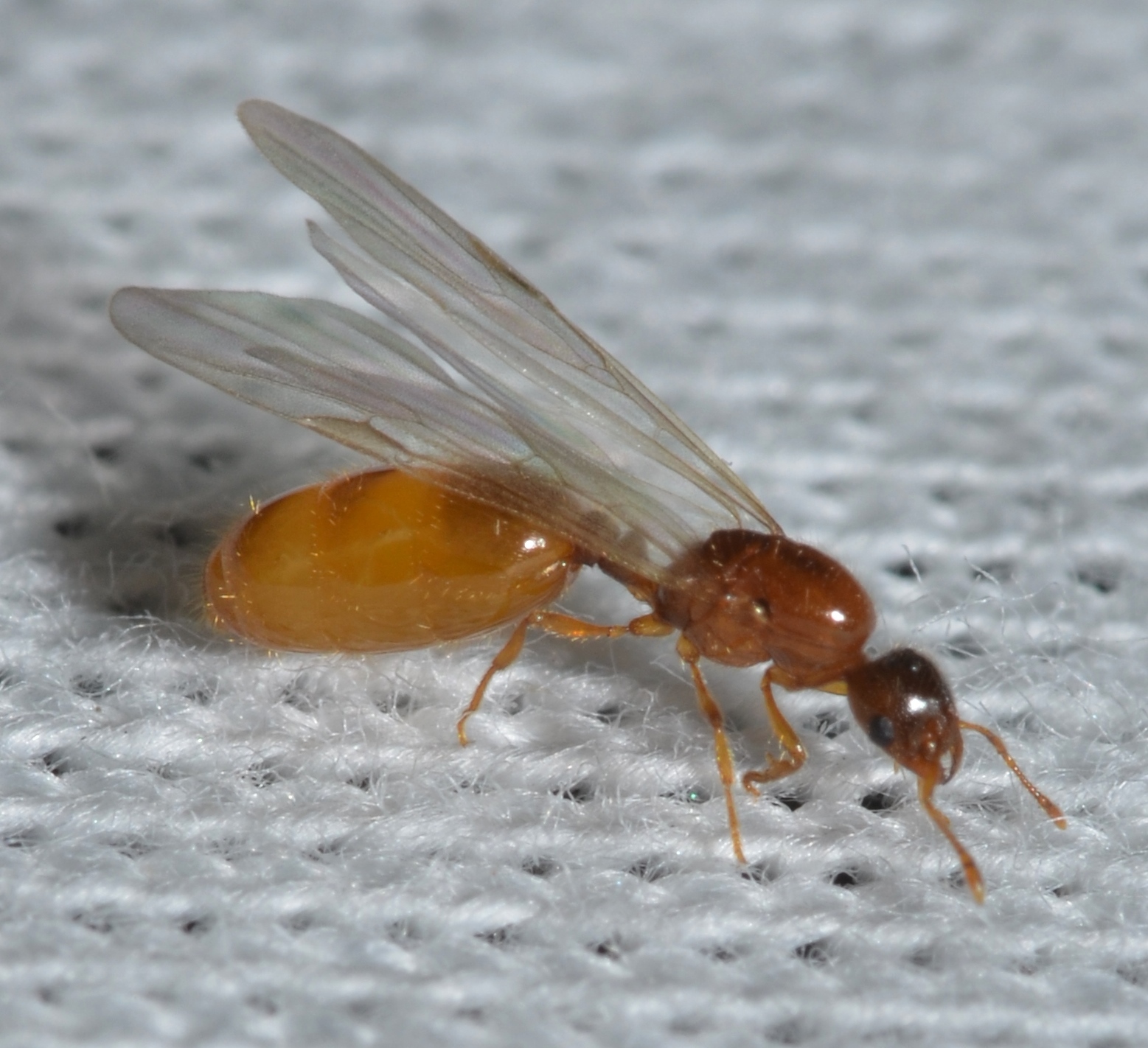
Thief ants are tiny, usually 1/16 to 1/12 inch long, making them difficult to spot with the naked eye. They are pale yellow to light brown and have a slender body with a two-segmented petiole (the narrow waist between the thorax and abdomen). Their small size often causes them to be overlooked in homes and gardens.
The name “thief ant” comes from their habit of nesting close to other ant colonies and stealing food or brood from them. Their mandibles are small but capable of a painful pinch, especially when they are disturbed while foraging. They also have an unmistakable “citrusy” odor when crushed.
Thief ants are highly secretive and prefer to build their nests in hidden, protected areas. In Ohio, they are commonly found under rocks, inside wall voids, in soil near foundations, or under leaf litter. They are particularly attracted to greasy or protein-rich foods.
Distribution in Ohio is widespread, especially in urban and suburban areas. Their colonies are small, but they can multiply quickly indoors if food sources are abundant. They are most noticeable during late spring through early fall when foraging activity is at its peak.
Odorous House Ant (Tapinoma sessile)
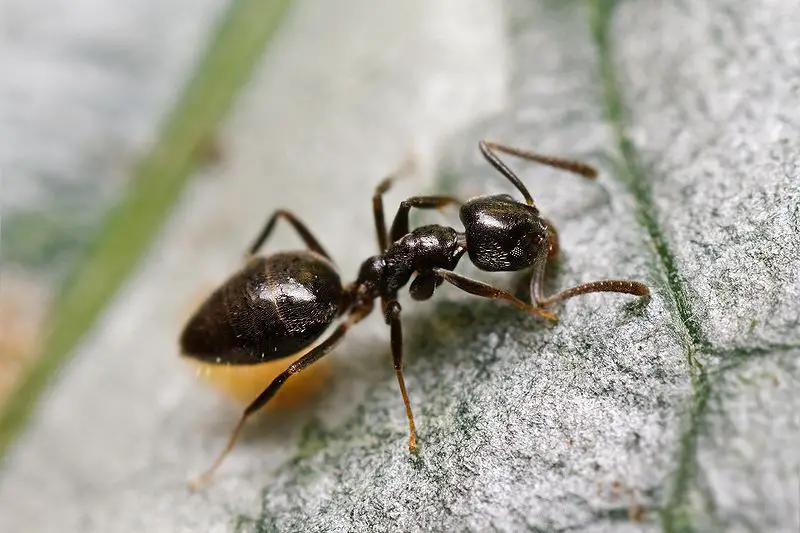
Odorous house ants are small, about 1/12 inch long, dark brown to black, and have a smooth, shiny body. They are easily identified by the strong, coconut-like odor they release when crushed, which is the reason for their common name. Their single-segmented petiole gives their waist a subtle, rounded appearance.
Behaviorally, these ants are highly social and form large colonies with multiple queens, which makes them very persistent indoors. They primarily feed on sweets and honeydew from aphids, though they will scavenge protein when available. Their bites are minor but their presence can be a nuisance.
Odorous house ants are very adaptable and can nest both indoors and outdoors. Common outdoor nesting sites include under stones, logs, or mulch. Indoors, they establish themselves in wall voids, insulation, or behind baseboards, often near food sources.
In Ohio, odorous house ants are particularly common in urban areas, with peak activity during the warm months from late spring to early fall. Their colonies can expand rapidly, and multiple satellite nests often appear, making control challenging without addressing all entry points.
Cornfield Ant (Lasius neoniger)
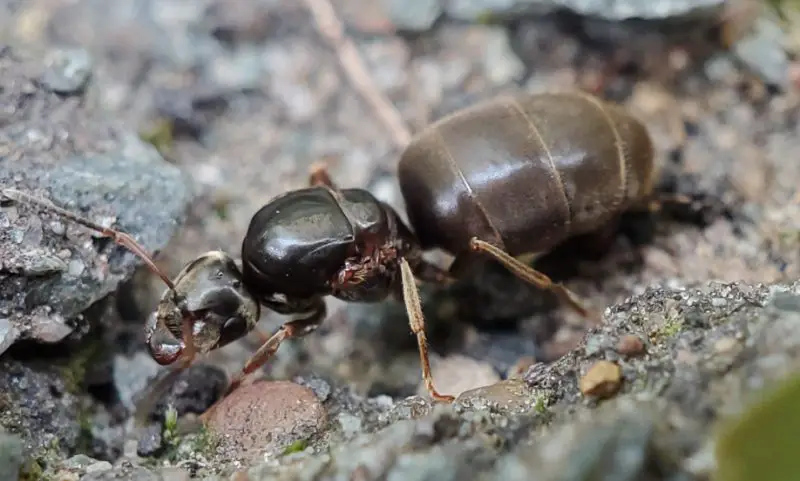
Cornfield ants are small to medium-sized ants, measuring 1/12 to 1/8 inch long. They are yellow to light brown and have a smooth body with a single-segmented petiole. Their eyes are prominent, giving them good vision for foraging and navigation. Unlike some other ants, they are not aggressive indoors.
They earned the name “cornfield ant” due to their prevalence in open fields and agricultural areas, particularly in corn and grain fields. Their mandibles can deliver a pinch if handled, but they primarily use them for carrying food and defending the colony.
Cornfield ants build small soil mounds for nests in open, sunny areas. These mounds are usually less than 2 inches high but can be numerous in agricultural fields, lawns, or meadows. They are active foragers, particularly in the morning and evening, searching for honeydew, seeds, and small insects.
In Ohio, cornfield ants are common throughout the state in open fields, pastures, and lawns. They are more noticeable during late spring and summer, when worker ants leave the mound to forage. While they are a minor biting species, their colonies can be extensive in rural landscapes.
Pavement Ant (Tetramorium caespitum)
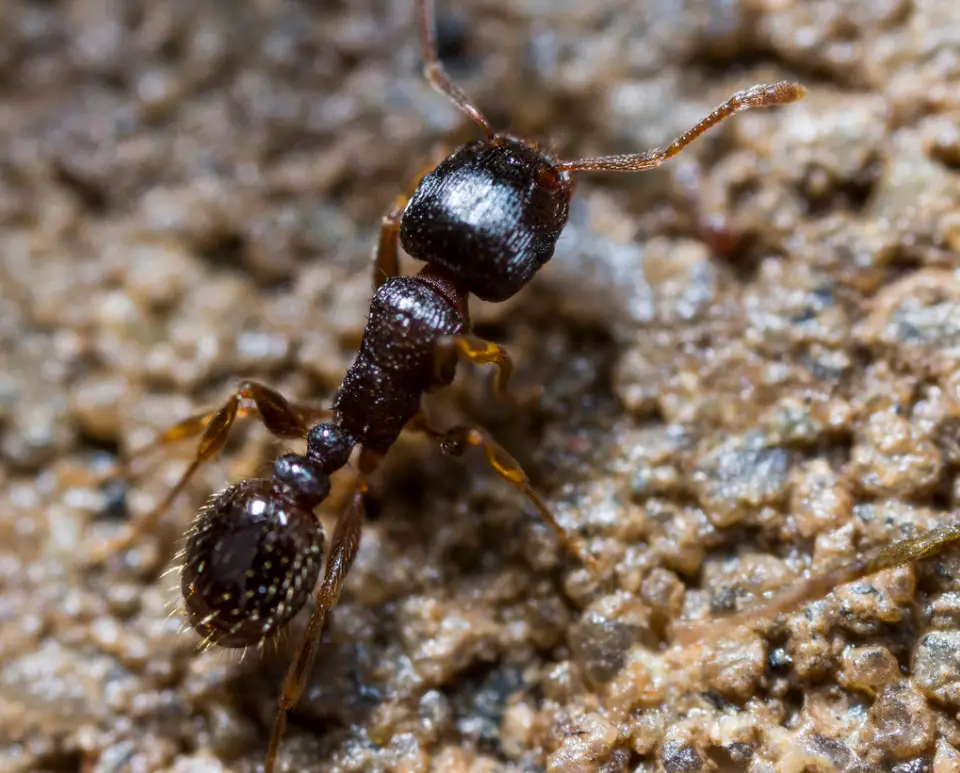
Pavement ants are small, dark brown to black ants, measuring 1/10 inch long. They have a slightly ridged thorax and a two-segmented petiole. The ridges on their thorax are an easy identification feature when observed closely. Their mandibles are strong, capable of delivering a painful pinch to humans if provoked.
These ants are highly territorial and often fight with neighboring colonies over food and nesting space. Pavement ants primarily feed on sweets but will consume proteins, grease, and insects. Their biting behavior is defensive rather than predatory.
Pavement ants build nests in cracks of sidewalks, driveways, patios, and building foundations. Their colonies are usually moderate in size but can grow large if food sources are abundant. They are most active during daylight hours, particularly in warm months.
In Ohio, pavement ants are common in urban and suburban areas. They are particularly noticeable during late spring and summer, when swarming and foraging activity increases. Their ability to nest in tight spaces makes them a frequent indoor nuisance in homes and businesses.
Field Ant (Formica spp.)
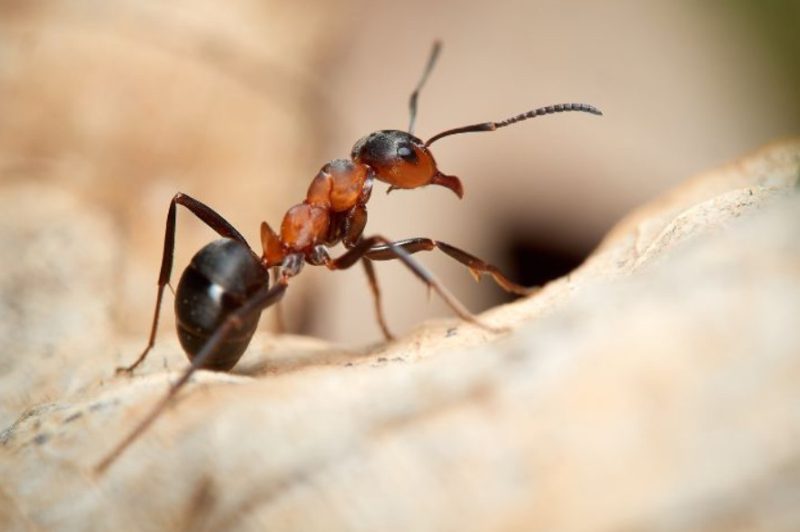
Field ants vary in size depending on the species, generally ranging from 1/8 to 3/8 inch long. Their coloration ranges from reddish-brown to black, and they often have a smooth, shiny exoskeleton. Field ants have a single-segmented petiole, and some species feature a small stinger used for defense.
Behaviorally, field ants are semi-aggressive and can deliver painful bites or spray formic acid when threatened. They are known for tending aphids to collect honeydew and for scavenging dead insects, seeds, and other organic matter.
Field ants build large mound nests in open fields, lawns, and forest edges. Their mounds can reach several inches in height and are often accompanied by visible trails of workers foraging for food. They are diurnal and highly active during warm days.
In Ohio, field ants are widespread in rural and suburban areas. They are most noticeable during the summer months when worker ants are actively foraging. While their bites can be painful, they rarely pose a serious threat to humans unless provoked repeatedly.
Carpenter Ant (Camponotus spp.)
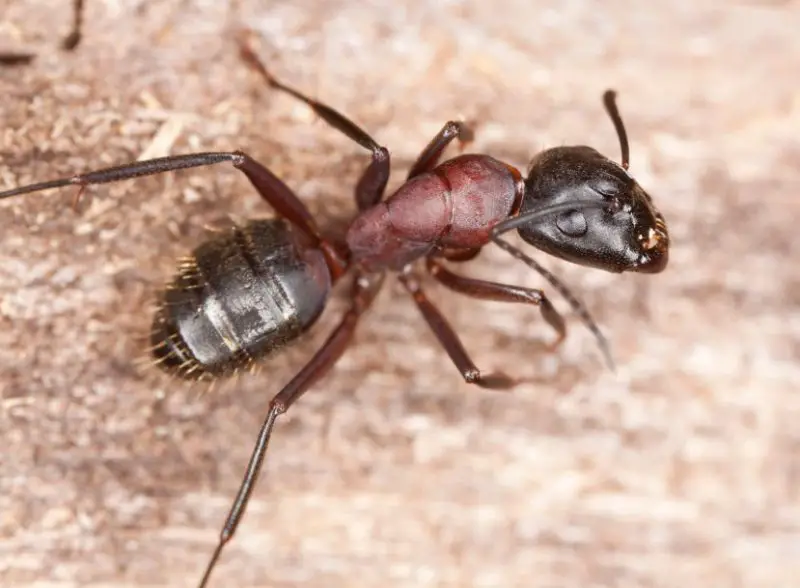
Carpenter ants are among the largest ants in Ohio, ranging from 1/4 to 1/2 inch long. Their coloration varies from black to reddish-black, and they have a smooth, rounded thorax with a single-segmented petiole. Their mandibles are strong, allowing them to deliver a painful bite and to excavate wood for nesting.
Unlike many other ants, carpenter ants do not eat wood; they chew it to create tunnels and galleries for their nests. Their diet consists mainly of proteins, sugars, and honeydew from aphids. Carpenter ants are primarily nocturnal, though foraging activity can occur during the day in shaded areas.
They commonly nest in moist or decaying wood, including tree stumps, logs, wooden structures, and sometimes the framing of homes. Colonies can be large, with thousands of workers and multiple satellite nests surrounding the main nest.
In Ohio, carpenter ants are widespread in forested areas and suburban regions with older homes. They are most active during the warmer months, from late spring through summer, and their presence can be indicated by sawdust-like frass near wooden structures. Bites are usually defensive and occur if the ant is handled or trapped against the skin.
Citronella Ant (Lasius interjectus)
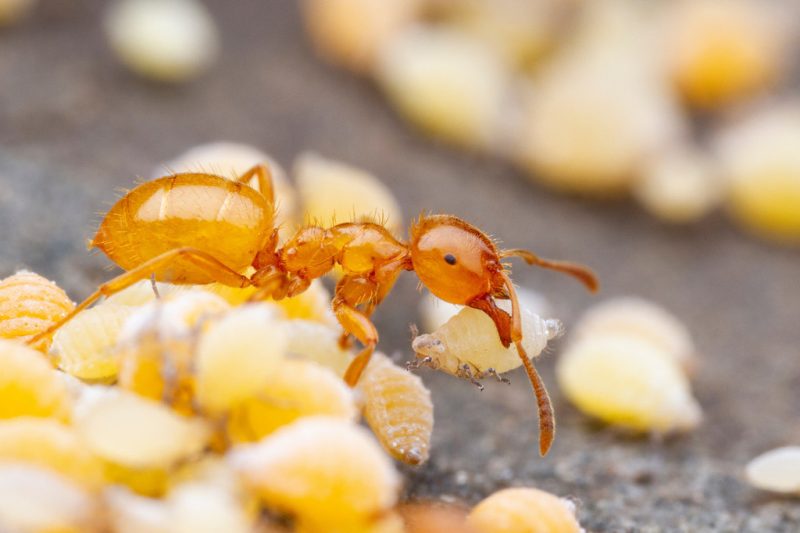
Citronella ants are small, measuring 1/16 to 1/8 inch long, and range from yellowish to light brown. They are closely related to odorous house ants and are easily recognized by the lemony or citronella scent they release when crushed. Their bodies are smooth, with a single-segmented petiole.
These ants are timid but can deliver a mild bite if provoked. They primarily feed on honeydew produced by aphids and other small insects, but they also scavenge small protein-rich items. They are not aggressive toward humans, making their bite rare.
Citronella ants build nests in soil, often under stones, logs, or mulch in sunny or semi-shaded areas. Colonies are usually small but can spread through multiple interconnected nests, especially near gardens or lawns.
In Ohio, citronella ants are common in gardens, lawns, and open fields. They are most visible during late spring and summer, particularly when workers forage for honeydew or small insects. Their citronella odor is a key identification feature for gardeners and homeowners.
Allegheny Mound Ant (Formica exsectoides)
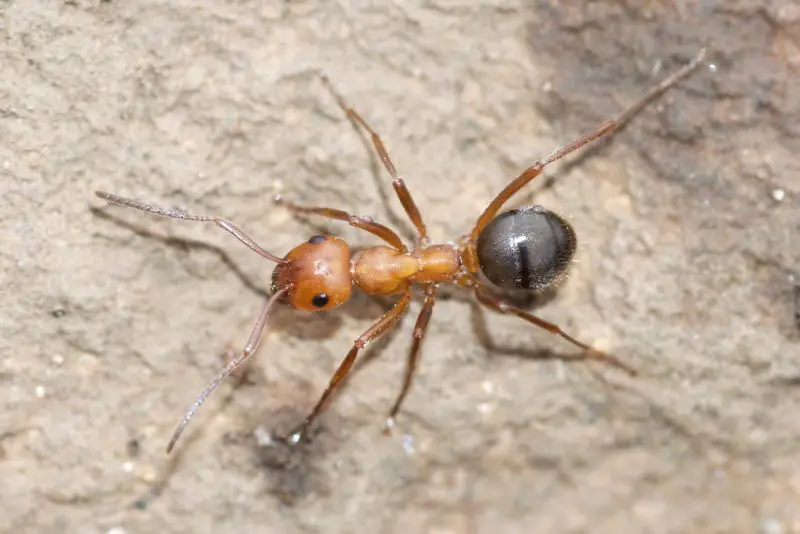
Allegheny mound ants are medium-sized ants, approximately 1/4 inch long, with a reddish-brown to dark brown coloration. They have a smooth, shiny body with a single-segmented petiole and a small stinger. Their robust mandibles can deliver a painful pinch when they feel threatened.
These ants are known for building large, conical mounds that can reach over 2 feet in diameter. Each mound houses thousands of workers and multiple queens, forming expansive colonies. They feed on honeydew, insects, and other organic materials, often protecting aphids to harvest their secretions.
Allegheny mound ants are aggressive defenders of their nests. When disturbed, workers swarm to bite intruders and spray formic acid, which intensifies the sting. Their territorial nature helps maintain the structure and integrity of their mounds.
In Ohio, these ants are commonly found in forests, fields, and sometimes in landscaped yards. Their mounds are most noticeable during late spring and summer, and they can persist for many years if undisturbed. Bites can be painful but are rarely medically significant.
Acrobat Ant (Crematogaster spp.)
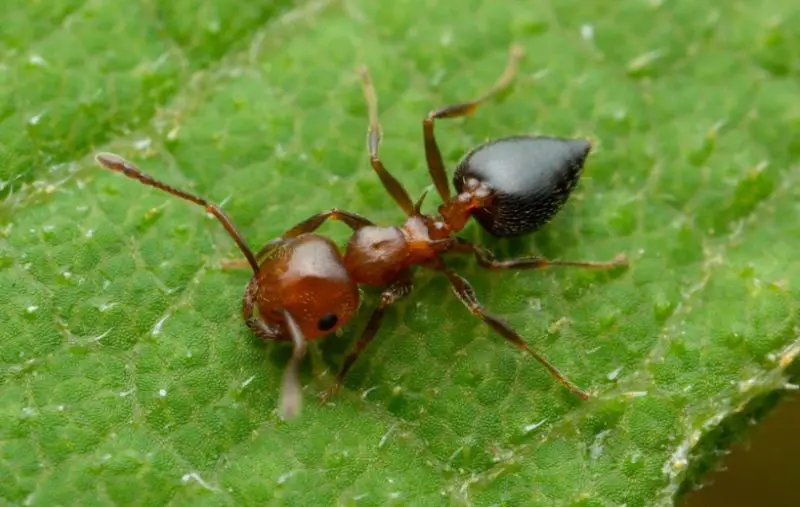
Acrobat ants are small to medium-sized, ranging from 1/10 to 1/8 inch long, with a reddish-brown body and darker head and thorax. Their abdomen is heart-shaped when viewed from above, giving them the name “acrobat.” They have a single-segmented petiole and are capable of bending their abdomen over their thorax when threatened.
These ants are not highly aggressive but will bite and release formic acid when disturbed. They primarily feed on insects, honeydew, and sugary substances. Acrobat ants are also known for inhabiting decaying wood, under bark, or in structural voids.
Nesting occurs in moist, rotting wood, tree stumps, or inside homes in damp areas such as wall voids or insulation. Their colonies are moderate in size but can establish multiple satellite nests to expand territory.
In Ohio, acrobat ants are common in wooded areas, forest edges, and urban settings where decaying wood is present. They are most active during spring and summer, often observed foraging along tree trunks or on the ground. Their bite is defensive and rarely serious but can cause irritation.
Tips for Identification and Safety Around Biting Ants in Ohio
How to Identify Biting Ant Species
Observing key physical traits is essential for identifying biting ants. Look at the size, color, and body shape: Thief Ants are tiny and pale, Odorous House Ants are dark brown with a coconut-like smell, and Acrobat Ants have a distinctive heart-shaped abdomen. Noting the presence of petiole segments and mandible size can also help distinguish species.
Recognizing Ant Nests and Mounds
Different species build different types of nests. Pavement Ants often nest in sidewalk or driveway cracks, while Allegheny Mound Ants construct large, conical soil mounds in open fields or forest edges. Carpenter and Acrobat Ants prefer decaying wood or structural voids. Observing these nesting patterns can help prevent accidental bites.
Avoiding Bites Outdoors
When in areas with active ant colonies, wear shoes and avoid stepping on nests or mounds. Do not disturb ants with sticks or hands, as most species bite defensively. Pay attention to visible trails of foraging ants, especially in lawns, gardens, and wooded areas during warm months.
Preventing Indoor Infestations
Seal cracks and gaps in windows, doors, and foundations to prevent ants from entering homes. Keep food sealed and clean up crumbs or spills immediately. Odorous House Ants and Thief Ants are particularly prone to entering homes in search of food, so regular monitoring and sanitation are key.
What to Do If Bitten
Most ant bites cause minor pain, redness, or itching. Wash the affected area with soap and water, and apply an antiseptic or anti-itch cream if necessary. Seek medical attention if there is a severe allergic reaction, swelling, or multiple bites from species like Carpenter Ants or Allegheny Mound Ants.
FAQs About Biting Ants in Ohio
What types of biting ants are found in Ohio?
Ohio hosts several biting ant species, including Thief Ants, Odorous House Ants, Cornfield Ants, Pavement Ants, Field Ants, Carpenter Ants, Citronella Ants, Allegheny Mound Ants, and Acrobat Ants. Each species differs in size, behavior, and habitat, ranging from small indoor ants to large forest-dwelling mound builders.
Do all biting ants in Ohio pose a threat to humans?
Most biting ants in Ohio are not dangerous to humans, but their bites can be painful or irritating. Species like Carpenter Ants, Allegheny Mound Ants, and Acrobat Ants deliver stronger bites or spray formic acid, which can cause localized pain or redness. Most others, such as Thief Ants and Cornfield Ants, pinch defensively but rarely cause serious harm.
Where are biting ants most commonly found in Ohio?
Biting ants occupy a range of habitats. Indoor species, such as Odorous House Ants and Thief Ants, prefer wall voids, kitchens, and hidden crevices. Outdoor species, like Cornfield Ants and Allegheny Mound Ants, are often found in open fields, lawns, forests, or decaying wood. Pavement Ants commonly nest in cracks in sidewalks, driveways, and patios.
How can I identify a biting ant in my home or yard?
Identification depends on size, color, body shape, and odor. Odorous House Ants emit a coconut-like smell when crushed, Citronella Ants smell like lemon, and Acrobat Ants have a heart-shaped abdomen. Observing nests, foraging behavior, and mound structures can also help distinguish species.
What is the best way to prevent bites from ants in Ohio?
To prevent bites, avoid disturbing ant nests and keep food sources sealed indoors. Maintain clean outdoor areas, remove decaying wood, and seal entry points to homes. For larger species like Carpenter Ants or Allegheny Mound Ants, professional pest control may be necessary if nests are near structures.
When are biting ants most active in Ohio?
Biting ants are most active during the warmer months, from late spring through summer. Worker ants forage during daylight hours, though some species, such as Carpenter Ants, are more active at night. Peak activity periods increase the likelihood of encountering bites.


